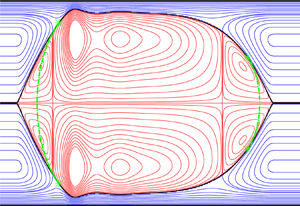No CrossRef data available.
Published online by Cambridge University Press: 04 November 2024

We study liquid plugs in the pulmonary airways based on the two-phase axisymmetric weighted residual integral boundary-layer model of Dietze et al. (J. Fluid Mech., vol. 894, 2020, A17), which was originally developed to study liquid films coating the inner surface of a cylindrical tube in interaction with a core gas flow. The augmented form of this model, which was never applied beyond a proof of concept, allows for the representation of liquid pseudo-plugs. Here, we demonstrate its predictive power vs experiments and direct numerical simulations, in terms of the dynamics of plug formation and the characteristics of developed liquid plugs, such as their shape, flow field, speed and length, as well as the associated wall stresses and their spatial derivatives. In particular, we show that the augmented model allows us to establish a direct continuation path from travelling-wave solutions (TWS) to travelling-plug solutions (TPS). We then apply the model to predict mucus plugs in the conducting zone of the tracheobronchial tree, based on the lung architecture model of Weibel. We proceed by numerical continuation of travelling-state solutions in terms of the airway generation, whereby we impose the wavelength of the linearly most-amplified convective instability (CI) mode or that of the absolute instability (AI) mode. We identify the critical airway generation for liquid-plug formation (TWS/TPS transition), maximum potential for wall-stress-induced epithelial cell damage and CI/AI transition, and investigate how these phenomena are affected by the main control parameters, i.e. airway orientation vs gravity, air flow rate, mucus properties and airway size.